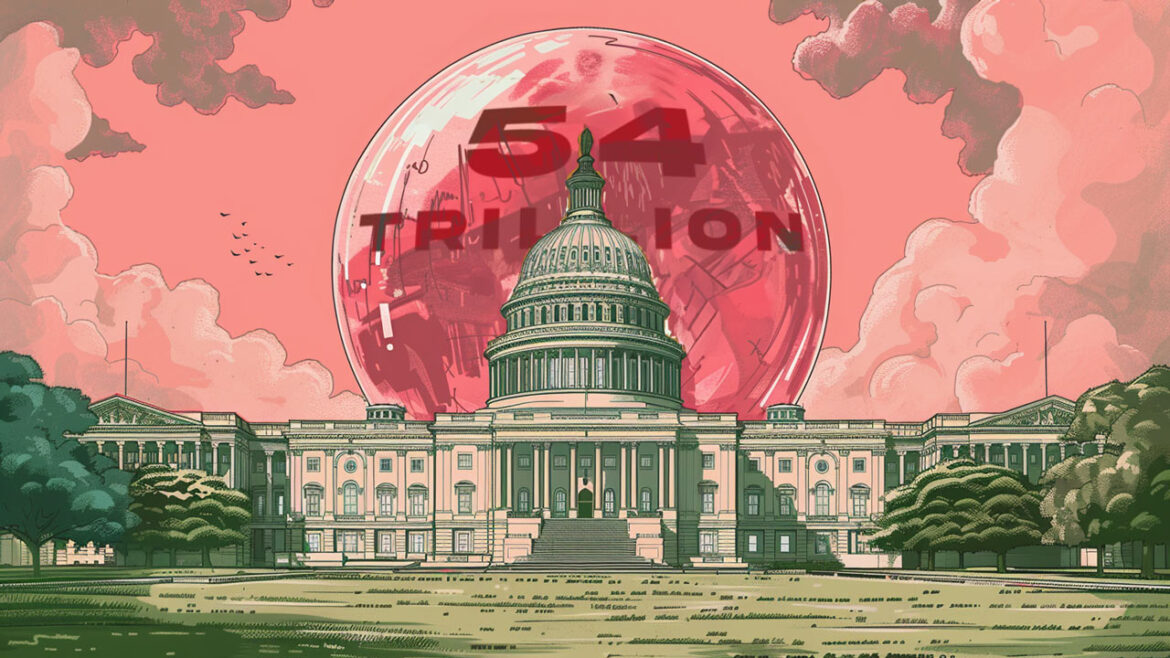Precious metals are apparently waking up. And here is where you can find the best deals.
Site:
Precious metals news
With a stunning trillion dollars added to the national debt in only three months, projected to reach an incomprehensible $54 trillion within 10 years, and America’s interest payments on track to exceed defense spending next year, the question must be asked: How much longer can the debt bubble go?
Unfortunately, the market has based its foundation on the wrong type of collateral. Of course, this works when global energy production increases but fails miserably when the opposite occurs. It is important to understand the True Foundation of collateral and why one should invest in Gold and Silver...
Federal Reserve Chair Jerome Powell indicated that the Fed is nearing the point of being confident enough to begin reducing interest rates. Speaking to the Senate Banking Committee, Powell highlighted that the central bank's main condition for this shift is gaining assurance that inflation will stabilize around the 2% target. According to Powell, once the Fed attains this level of confidence, which he suggests is not far off, it will consider it appropriate to start easing the current restrictive monetary policy. This statement offers a glimpse into the Fed's strategic outlook on managing inflation and interest rates, suggesting a potential upcoming shift in policy to stimulate economic growth.
Big banks in the U.S. have successfully lobbied for a change to a contentious regulation that mandated them to maintain larger financial reserves as a safeguard against potential future losses. This week, Federal Reserve Chair Jay Powell and FDIC Chair Martin Gruenberg announced their expectation to amend this rule, following extensive pressure not just from the banking sector, but also from community groups, Republican and Democratic lawmakers alike. The move signifies a significant policy shift influenced by a broad coalition of stakeholders, highlighting the power of financial institutions in shaping regulatory frameworks.
 February Layoffs Hit Record High Since 2009, Tech and Finance Sectors Lead the Pack
February Layoffs Hit Record High Since 2009, Tech and Finance Sectors Lead the PackMar 7, 2024 - 12:58:15 PST
Layoff announcements in February soared to their highest level for the month since the 2009 global financial crisis, as reported by Challenger, Gray & Christmas. The month witnessed 84,638 planned layoffs, marking a 3% increase from January and a 9% rise from February of the previous year. The technology and finance sectors were particularly hit hard. This spike in layoffs represents the most challenging February since 2009, during which 186,350 layoffs were announced as the financial crisis was nearing its end. Interestingly, the financial markets found their footing in March 2009, leading to the longest period of economic expansion, which lasted until the onset of the Covid pandemic in March 2020.
For the 16th consecutive month, China's central bank, the People's Bank of China, has continued to increase its gold reserves, adding approximately 390,000 troy ounces in February. This persistent acquisition spree has played a significant role in propelling gold prices to unprecedented heights. As of the latest data, China's total gold reserves now amount to roughly 72.58 million troy ounces, or about 2,257 tons, underscoring the nation's strategic move to bolster its financial stability and diversify its asset base amidst global economic fluctuations.
This week, gold rose as high as $2,161/oz, surpassing the significant $2,100 milestone and marking a historic moment for gold investors.
As gold prices soared to unprecedented heights for the fifth consecutive day, reaching as high as $2,153 per troy ounce, it's clear that the rally is driven by more than just the current U.S. economic climate and anticipation of Federal Reserve policy shifts. While traders' expectations of imminent interest rate cuts by the Fed play a significant role—contributing to lower Treasury yields and a weaker dollar, thus making gold, a non-yielding asset, more appealing—the narrative surrounding gold's ascent isn't entirely straightforward. This complex interplay of factors underlines the intricate dynamics at play in the gold market, where confidence in traditional financial instruments wanes, and investors increasingly turn to the precious metal as a safe haven amid economic uncertainty.
 New Billboard in Times Square Sounds Alarm on $34 Trillion National Debt Crisis
New Billboard in Times Square Sounds Alarm on $34 Trillion National Debt CrisisMar 7, 2024 - 08:19:52 PST
In the heart of New York City's Times Square, a towering 50-foot billboard has been unveiled by the Committee to Unleash Prosperity (CTUP), striking a chord of caution among Americans with its stark warning about the nation's burgeoning $34 trillion debt. This three-month-long ad campaign is designed to visually encapsulate the perilous journey of the American economy under the weight of what the nonprofit describes as Washington D.C.'s reckless fiscal policies.
Federal Reserve Chair Jerome Powell stated on Wednesday that while the Fed anticipates reducing its key interest rate within the year, it seeks further proof of inflation steadily reverting to its 2% goal before taking action. His remarks to a House committee were consistent with his previous comments at a January 31 news conference. Nevertheless, subsequent reports have indicated a rise in inflation from December to January, alongside a boost in employment, signaling that the economy continues to be robust. Despite the recent inflationary uptick, Powell remained unperturbed, highlighting that, according to the Fed's preferred measure, inflation has significantly moderated over the last year, even though it still surpasses the Fed's target.
Gold's rise to a record high this week has left some analysts scratching their heads, wondering how much higher it can possibly climb. The unexpected 5% spike in gold prices over the last four trading days, culminating in surpassing the previous December peak, can be attributed to a cocktail of weak US economic data and banking sector anxieties. This surge, especially without clear signals of an impending shift in the Federal Reserve's interest rate policies, has been surprising. Moreover, the current global climate, rife with geopolitical tensions, along with gold's resilient performance in the past year despite rising real interest rates, suggests a bullish horizon for the precious metal. This complex scenario underscores a potentially favorable future for gold, hinting at sustained high prices or even further increases.
Everyone’s heard of Javier Milei, the new president of Argentina, called by Fox News the world’s first libertarian president. He has been in the news for his denunciation of leftism, Marxism, and the sprawling bureaucracy that has trapped Argentina in debt. He’s also taken aim at run-away inflation in Argentina. Inflation in the last year was over 200% in Argentina, a rate that the United States hasn’t reached, even with Biden-levels of inflation.
I can honestly say that when I looked at Fresnillo's 2023 Year-end Results, I was stunned by how much their silver mining costs increased in the second half of the year. Even with record silver production and higher prices, Fresnillo's financials were dismal...
Ron Paul’s recent op-ed from the Ron Paul Institute for Peace and Prosperity, reprinted in the Orange County Register, breaks down the profound damage caused by central bank money printing: it pits savers against speculators, encouraging consumers to use debt to fund basic needs since their savings are constantly evaporating due to monetary debasement.
Under new regulations introduced by the Joe Biden administration, millions of Americans will see a reduction in credit card fees. The White House announced that the Consumer Financial Protection Bureau (CFPB) has completed a ruling that significantly lowers the standard credit card late fee from an average of $32 down to $8. This move aims to alleviate the financial burden on consumers and marks a substantial shift in credit card fee policies.
New York Community Bancorp dropped as much as 32% on a report that the beleaguered regional bank is trying to raise equity capital to restore confidence.
In the midst of a global "everything rally," where asset classes across the board—from U.S. to Japanese and German stocks, alongside bitcoin—are reaching record highs, gold's unprecedented climb stands out for several reasons. Despite the typical pattern of rising prices attracting speculative interest, gold ETF holdings have surprisingly declined even as its price surged, a phenomenon highlighted by Jim Bianco of Bianco Research. Contrary to expectations, gold's value has increased amidst a strengthening dollar and diminishing expectations for Federal Reserve interest rate cuts.
In February, private sector employment experienced a modest uptick with 140,000 new jobs added, slightly under the anticipated 150,000, according to ADP. This growth represents an improvement from January's revised figure of 111,000. The leisure and hospitality sector was the leading contributor, adding 41,000 jobs, followed by construction with 28,000, and trade, transportation, and utilities with 24,000. This report serves as a precursor to the more comprehensive nonfarm payroll figures from the Labor Department, expected to be released on Friday.
Federal Reserve Chair Jerome Powell emphasized to lawmakers that the Fed is cautious about reducing interest rates prematurely, insisting on solid evidence of inflation control before making any moves. In his testimony, Powell suggested that while it might be suitable to decrease borrowing costs at some point this year, the Federal Reserve is not prepared to do so immediately. This stance aligns with recent sentiments from various Fed officials who highlight the current strength of the economy and labor market as reasons to wait for clearer signs of inflation returning to target levels before considering rate cuts.
 Gold Price Hovers at Record Peaks: Eyes Set on Fed's Powell for Rate Cut Hints
Gold Price Hovers at Record Peaks: Eyes Set on Fed's Powell for Rate Cut HintsMar 6, 2024 - 06:53:51 PST
Gold prices edged higher on Wednesday, lingering near the record highs set in the previous session, with investors eagerly awaiting Federal Reserve Chair Jerome Powell's upcoming testimony for indications of a possible interest rate cut in June. Spot gold rose by 0.3% to $2,132.80 per ounce by midday, just shy of its historic peak of $2,141.59 reached the day before. Similarly, U.S. gold futures remained stable at $2,141.60. The precious metal's climb to new heights isn't just in dollars; it has also reached record levels in other major currencies, reflecting its global appeal as a safe haven amid economic uncertainty.











